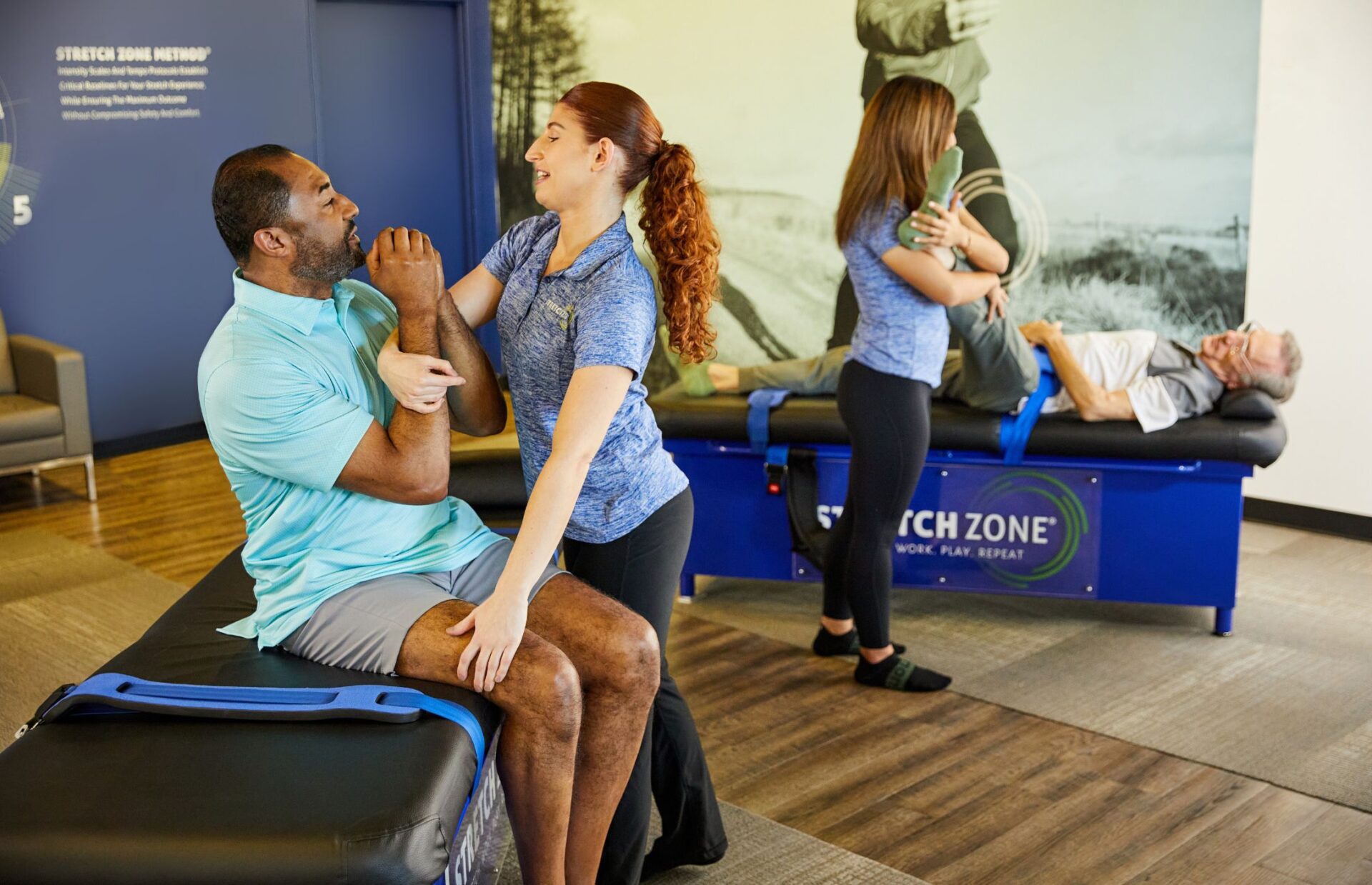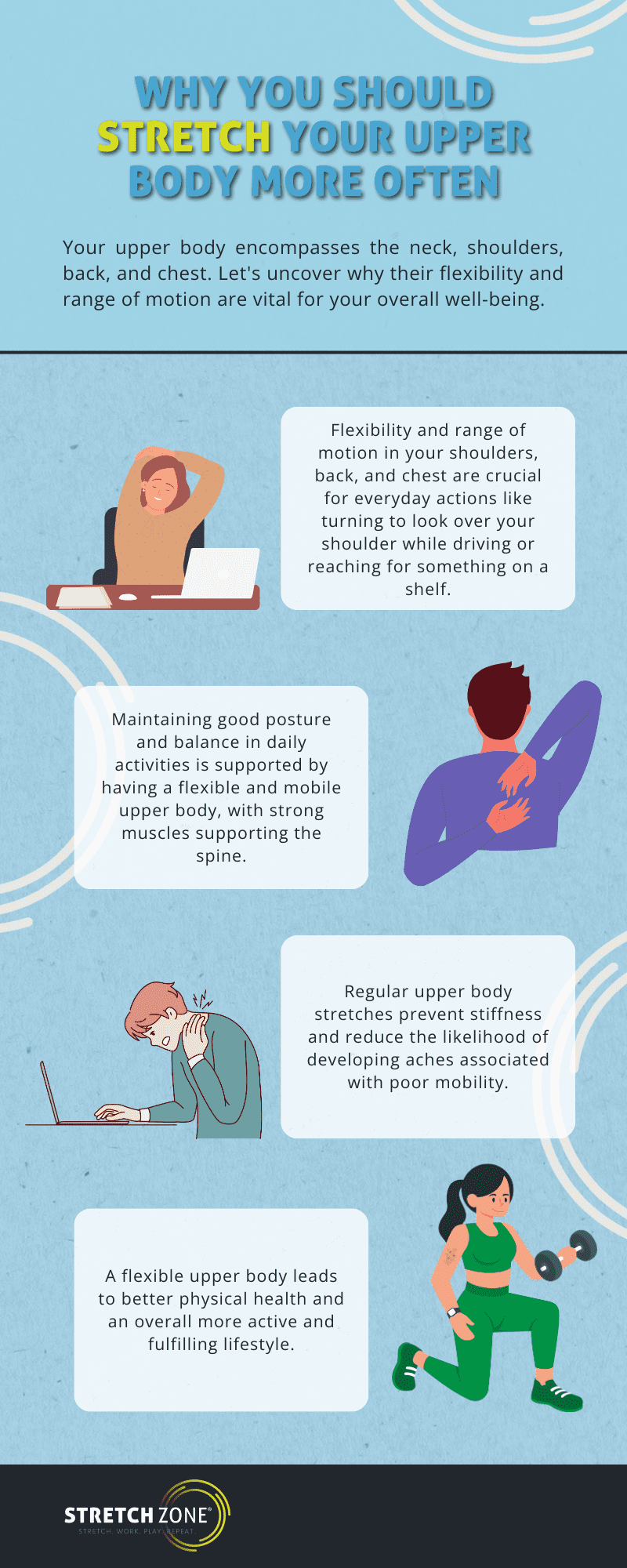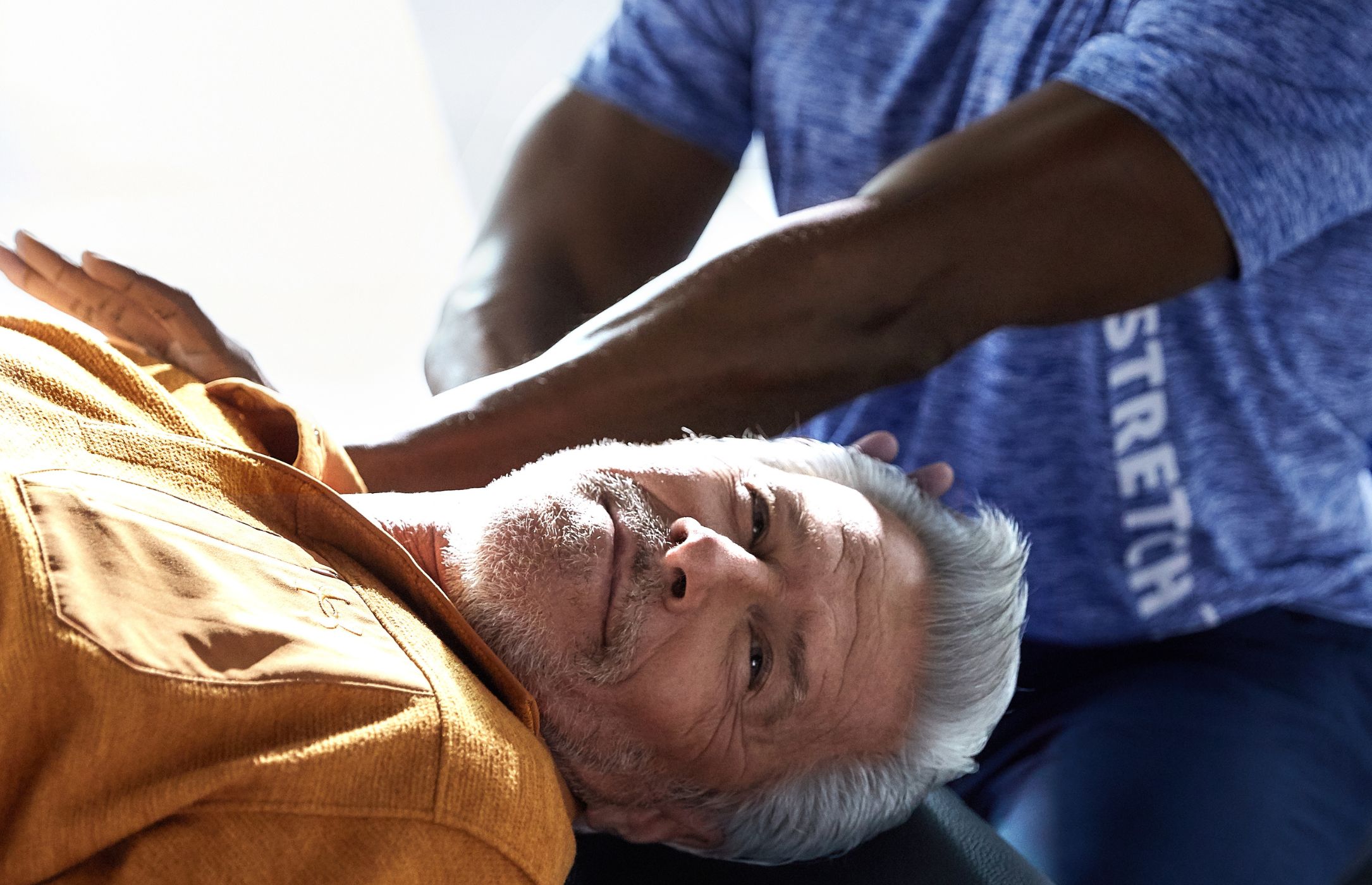
Why You Should Stretch Your Upper Body More Often
In our busy lives, we often overlook the strength tucked away in our upper body. While we might take care of various aspects of our health, the shoulders, back, neck and chest quietly carry their weight and deserve some attention too.
Consider reaching for something high or turning to fasten your seatbelt, maybe bending and lifting your kids or grandkids—these actions all rely on your upper body. The beauty is, with upper body stretches such as back, arms, and chest stretches, we can care for those areas and enhance how we move. This means enjoying and being able to do these activities more freely. So, let’s dig deeper into why starting to stretch your upper body today can make a real difference.
Getting to Know Your Upper Body
Your upper body encompasses the neck, shoulders, back, and chest, each playing a distinctive role in supporting and facilitating a variety of movements essential to daily life.
- Neck: The neck serves as a crucial connector between the head and the torso. The cervical spine and surrounding muscles allow for essential movements like turning, tilting, and nodding, contributing to the overall flexibility and functionality of the upper body.
- Shoulders: Your shoulders are the versatile leaders of the upper body. The deltoids shape your shoulders, while the rotator cuff muscles allow for everyday movements like lifting, swinging, and reaching.
- Back: Moving to the back, it acts as the support system for your body. The spine is the backbone, and muscles like the latissimus dorsi and trapezius play essential roles in maintaining posture, enabling you to stand tall, twist, and bend.
- Chest: Lastly, the chest houses the pectoral muscles, central to actions like hugging, pushing, and pulling. These muscles are pivotal in various upper body movements, making everyday activities smoother.
Why You Should Work on a Flexible Upper Body
Now that we’ve met the key players in your upper body, let’s uncover why their flexibility and range of motion are vital for your overall well-being.
Facilitating Everyday Movements
Your upper body is the linchpin for everyday actions. From turning to look over your shoulder while driving to reaching up for something on a shelf, these seemingly simple tasks rely heavily on the flexibility and range of motion of your shoulders, back, and chest.
Enhancing Posture and Balance
A flexible and mobile upper body contributes significantly to maintaining good posture. The muscles supporting your spine play a crucial role in standing tall and moving gracefully, promoting better balance in your daily activities.
Preventing Aches
Stiffness in the upper body can lead to discomfort and even aches. By keeping these muscles supple through regular stretches, you not only prevent stiffness but also reduce the likelihood of developing aches associated with poor upper body mobility.
Supporting Overall Physical Health
Flexibility in your upper body is not just about reaching or bending; it’s about fostering a healthy, resilient body. A well-maintained upper body enhances your overall physical health, contributing to a more active and fulfilling lifestyle.
Habits That Can Adversely Affect Your Upper Body
Certain habits may unknowingly contribute to lack of flexibility, discomfort and strain in the chest, shoulders, back, and neck. Identifying and addressing these habits can significantly impact the health of your upper body. Let’s explore common practices that may be hurting these specific areas.
Prolonged Sitting
Extended periods of sitting, prevalent in desk jobs or sedentary lifestyles, can lead to poor posture, causing strain in the chest, shoulders, and back. Implementing breaks and incorporating stretches throughout the day can mitigate these effects.
Incorrect Screen Height
Improperly positioned computer screens can contribute to neck and shoulder discomfort. Ensuring that screens are at eye level helps maintain a neutral neck position, reducing the risk of strain.
Heavy Backpacks or Bags
Carrying heavy backpacks or shoulder bags can strain the shoulders and back. Distributing weight evenly, using backpacks with padded straps, and opting for crossbody bags can alleviate this burden.
Poor Sleeping Positions
Sleeping in positions that strain the neck or back can contribute to discomfort. Utilizing supportive pillows and maintaining proper sleep posture can promote spinal alignment and reduce strain.
Overlooking Ergonomics
Neglecting ergonomic considerations in work or home environments can lead to poor posture and discomfort. Adjusting furniture and equipment to support a natural body position helps prevent strain in the upper body.
Excessive Phone Use
Constantly looking down at phones can strain the neck and contribute to “text neck.” Holding phones at eye level or taking breaks from prolonged use can alleviate this strain.
Lack of Physical Activity
A sedentary lifestyle can weaken the muscles in the chest, shoulders, and back. Incorporating regular physical activity, including targeted upper body exercises, helps maintain muscle strength and flexibility.
Recognizing Signals for Upper Body Attention
It’s easy to overlook the subtle cues your body gives, but certain signs may indicate that your chest, arms, and back require a bit more care. Recognizing these common symptoms is the first step toward a healthier upper body.
Tension in the Chest
If you frequently experience tightness or tension in your chest, especially after long hours of sitting or working, it’s a signal worth noting. This tension can contribute to poor posture and limit your range of motion.
Aching Arms
Persistent discomfort or aching in your arms, particularly in the muscles or joints, could be an indication that your upper body needs attention. This is especially common if you engage in repetitive motions or spend extended periods typing or using handheld devices.
Back Discomfort
Whether it’s a dull ache or stiffness, any form of discomfort in your back, be it the upper, middle, or lower region, warrants attention. Back discomfort can stem from various factors, including poor posture, muscle imbalances, or stress.
Taking Action
If these symptoms resonate with you, it’s time to consider incorporating back, shoulder, and chest stretches into your routine. These upper back stretches can help alleviate tension, improve flexibility, and promote a healthier range of motion in these crucial areas.
Understanding a Bit More About Upper Body Stretches
Stretches for the upper back are designed to address muscles along the spine, promoting flexibility and easing tension in this crucial region. These movements contribute to a more supple and agile upper back, supporting better posture and reducing the risk of discomfort.
Chest Stretches
Chest stretches encompass a variety of movements that aim to elongate the muscles in the chest region. These stretches are designed to alleviate tension and promote the extensibility in the pectoral muscles, which play an important role in various upper-body movements.
Arm Stretches
Arm stretches focus on releasing tension in the shoulders and arms, targeting muscles such as the triceps and upper back. These stretches contribute to improved flexibility, providing relief from discomfort and enhancing overall mobility in the upper extremities.
Shoulder Stretches
Shoulder stretches play a pivotal role in maintaining upper body health. These movements specifically target the muscles around the shoulders, promoting flexibility and relieving tension. By incorporating shoulder stretches, individuals can foster greater mobility in this crucial joint.
Neck Stretches
Adding neck stretches to your routine is essential for maintaining overall upper body flexibility. Gentle stretches that involve turning, tilting, and nodding can alleviate neck tension, enhance mobility, and contribute to a well-rounded approach to upper body care.
The Uniqueness of Stretching for Upper Body Health
Now, you might find yourself wondering, why prioritize stretching for upper body health when activities like strength training and cardiovascular exercises, including swimming, also play important roles? While it’s true that these activities contribute significantly to overall health and your upper body, stretching brings a unique set of benefits to the table.
Gentle Flexibility Enhancement
Gentle stretching stands out as a specialized tool for enhancing flexibility, emphasizing a softer approach that is often overlooked in more dynamic exercises. The deliberate, gentle extension of muscles during stretches supports a broader range of motion in the upper body, promoting fluid movements and reducing the risk of stiffness.
Subtle Tension Release
In contrast to the dynamic nature of strength training, gentle stretching provides a nuanced approach to tension release. Specific gentle stretches pinpoint areas of tension, especially in the chest, arms, and back, offering subtle yet effective relief from tightness and contributing to a more relaxed upper body.
Improving Posture
Stretching plays an important role in improving posture by targeting muscles that influence alignment. While strength training contributes to muscle development, stretching complements these efforts by addressing imbalances and promoting a more upright and balanced stance.
Minimizing the Risk of Injury
Regular stretching contributes to injury prevention by preparing muscles and joints for the stresses imposed by other activities. This proactive approach reduces the likelihood of strains or injuries during strength training or cardiovascular exercises, fostering a safer and more sustainable fitness routine.
Holistic Approach to Well-Being
Stretching offers a holistic approach to well-being, emphasizing relaxation and mindfulness. Integrating stretching into your routine provides moments of focused attention on the body, promoting mental clarity and a deeper connection with your physical self.
Inclusive Nature of Gentle Stretching
The beauty of gentle stretching lies in its inclusive nature, welcoming individuals from various walks of life, including seniors and those leading sedentary lifestyles wanting to lead a more active lifestyle. Unlike more intense activities, gentle stretching offers a low-impact option that can be embraced by individuals of all fitness levels.
Starting Your Upper Body Stretching Routine
As you set out to incorporate upper body stretching into your routine, it’s understandable to feel tempted to turn to online resources for guidance. However, consider a more informed approach by seeking professional assistance, particularly through practitioner-assisted stretching.
Caution Against Independent Stretching
While online resources are abundant, attempting stretches without proper guidance can lead to ineffective results or, worse, injuries. Independent stretching may lack the precision needed to target specific areas of the upper body effectively.
Considering Professional Assistance
Rather than succumbing to the allure of online guides, consider the alternative of practitioner-assisted stretching. This approach involves working with trained professionals who can provide personalized guidance, ensuring that your stretching routine aligns with your individual needs and goals.
Benefits of Hands-On Expertise
One of the distinct advantages of practitioner-assisted stretching is the hands-on assistance provided by professionals. They guide your body through stretches with precision, focusing on areas that require attention. This personalized touch enhances the effectiveness of the stretches and reduces the risk of injury.
Opting for practitioner-assisted stretching over online self-guided methods prioritizes safety, effectiveness, and a more tailored approach to your upper body health.
Who Should Prioritize Upper Body Stretching and Why?
Well, at this point, we recognize the paramount importance of the upper body, and it’s clear that everyone should be incorporating stretching into their routine for this crucial part of the body. However, there are specific groups that stand to benefit even more. Let’s explore who should prioritize upper-body stretching and why.
Individuals with Sedentary Lifestyles
For those leading sedentary lifestyles, where long hours are spent sitting, upper body stretching is crucial. It helps alleviate tension, reduces the risk of postural issues, and counteracts the effects of prolonged sitting, promoting flexibility and overall well-being.
Office Workers
Individuals with desk-bound jobs often experience stiffness in the neck, shoulders, and back. Prioritizing upper body stretching aids in maintaining flexibility, reducing muscle tension, and preventing the discomfort associated with prolonged desk work.
Athletes
Athletes, depending on their sport, may subject their upper bodies to repetitive motions. Targeted stretching helps improve flexibility, enhances range of motion, and reduces the risk of injuries associated with sports-related stress on the upper body.
Seniors
As individuals age, maintaining flexibility becomes crucial for daily activities. Senior citizens benefit from upper body stretching to enhance joint mobility, reduce stiffness, and contribute to an overall improved quality of life.
Manual Laborers
Those engaged in manual labor, involving repetitive movements or heavy lifting, can benefit from upper body stretching to prevent muscle imbalances, reduce the risk of strains, and promote flexibility crucial for the demands of physical labor.
Individuals Recovering from Injury
People recovering from upper body injuries, such as shoulder or back issues, can expedite their rehabilitation through targeted stretching. It aids in restoring flexibility, reducing muscle tightness, and promoting a smoother recovery process.
Those with Stressful Lives
Whether it’s moms keeping up with kids or business professionals navigating demanding work routines, those with stressful lives can benefit from regular upper body stretching. Amidst the daily hustle, stretching provides a practical way to release tension, offering moments of physical and mental respite in the midst of hectic schedules.
Consequences of Neglecting Regular Upper Body Stretching
While we’re not suggesting immediate consequences, neglecting regular upper body stretching can gradually lead to increased muscle stiffness, a restricted range of motion, elevated risk of musculoskeletal injuries, and the development of poor posture.
Over time, the accumulation of tension may contribute to discomfort, affecting daily activities and potentially leading to chronic issues. It’s important to recognize the gradual impact of neglecting regular stretches on the overall health of the upper body.
FAQs: Navigating Your Upper Body Stretching Journey
How often should I incorporate upper body stretches into my routine?
The frequency of upper body stretches depends on individual factors, but aiming for at least 2-3 sessions per week is a good starting point. Consistency is key for seeing long-term benefits.
Can upper body stretching improve my posture?
Yes, targeted stretches for the shoulders, back, and chest can contribute to improved posture. These stretches help release tension, align the spine, and strengthen supporting muscles, promoting a more upright stance.
How do I know if I’m stretching correctly?
Proper form is crucial for effective and safe stretching. Consider seeking guidance from a certified stretch practitioner, especially if you’re new to stretching. They can ensure you’re performing stretches correctly to maximize their benefits.
Can upper body stretching help with stress relief?
Yes, upper body stretching can contribute to stress relief by releasing tension in muscles associated with stress and promoting relaxation. Incorporating deep breathing exercises along with stretches can enhance the stress-relieving effects.
When I start, should I tell my practitioner to focus solely on the upper body, or is a full-body stretch better?
It’s perfectly acceptable to communicate your preferences. Whether you opt for a targeted upper body stretch or a full-body session depends on your comfort level and specific goals. Discuss your preferences with your practitioner to ensure a session tailored to your needs, rest assured they will recommend what’s best for you.
Will I feel discomfort during a stretching session in a stretch studio?
Discomfort can vary from person to person, but it’s important to communicate with your practitioner. They can adjust the intensity of the stretches based on your feedback, ensuring a session that is effective yet within your comfort zone.
What if I’ve never stretched before? Can I still benefit from practitioner-assisted stretching?
Absolutely! Practitioner-assisted stretching is suitable for individuals of all experience levels. Whether you’re a beginner or have experience with stretching, your practitioner will guide you through the process, ensuring a safe and effective session tailored to your individual needs.
Unleash Freedom in Your Movements with Tailored Neck, Shoulder, and Chest Stretches
Incorporating upper body stretching into your routine may seem like a simple addition, but the benefits it brings to your daily life are nothing short of incredible. From improved flexibility and posture to a reduction in discomfort, these simple stretches can redefine the way you move and navigate everyday activities.
However, it’s important to remember that while the practice is accessible, consulting with a professional ensures you receive personalized guidance tailored to your unique needs.
Here at Stretch Zone, our certified stretch practitioners are dedicated to guiding you through personalized stretching sessions, ensuring targeted care for your shoulders, back, chest, and neck. Take the first step toward a supple and agile upper body—schedule your session at Stretch Zone today and discover the freedom that comes with intentional and expert-guided stretching.




